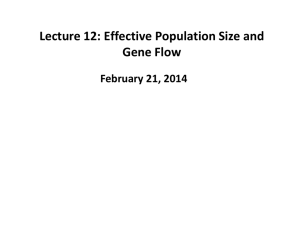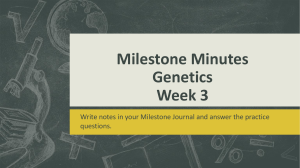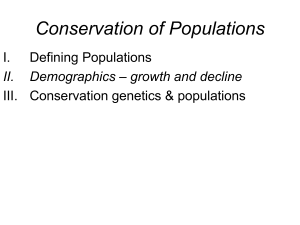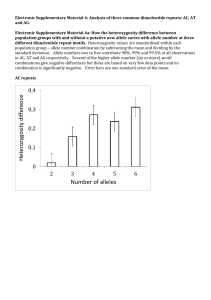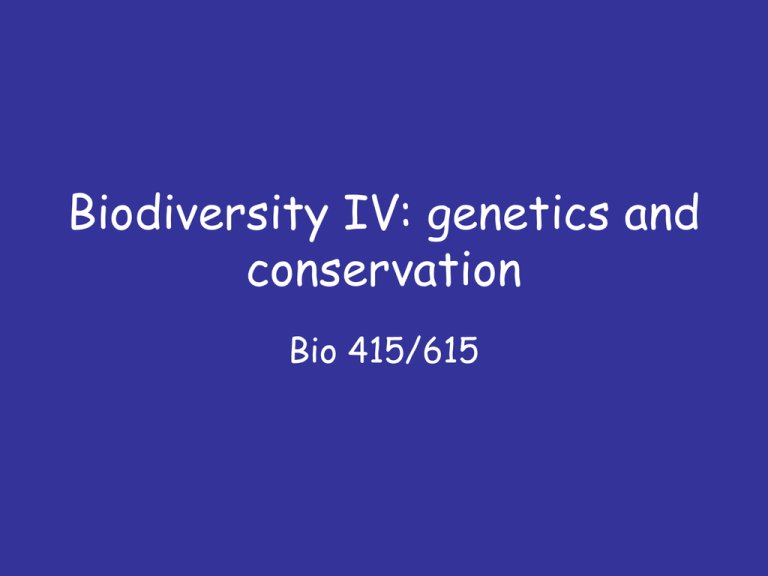
Biodiversity IV: genetics and
conservation
Bio 415/615
Questions
1. What is heterozygosity, and how
does it represent genetic
diversity?
2. What is the 50/500 rule for
conserving populations?
3. What factors influence effective
population size?
4. How is genetic diversity used for
descriptive vs. functional goals in
conservation?
Florida panther
• Lowest variation of 31 panther spp in N
and S America
– Allozyme polymorphism
• 4.9% vs. 7.3-17.1% at 41 loci
• Vs. museum specimens of Florida
panther
– 1.2 vs. 2.3 alleles per locus
Florida panther
• N = 80-100?
Allozyme DNA
He
He
–
–
–
–
Main population
Introgressed population
W’rn US
Other cats
1.8
1.8
4.3
3-8
10.4
29.7
46.9
• Inbreeding depression: abnormal sperm,
cardiac abnormalities, susceptibilty to
infectious diseases, cowlicks
Florida panther update
http://floridapanther.org
35 new kittens, 27 mortalities (2010-2011)
Heterozygosity
• Genes can exist in many forms called
alleles (big B, little b; dominant vs.
recessive)
• Alleles are specific to genetic loci =
region of DNA
• Heterozygosity is the proportion of
diploid genotypes in a population
composed of two different alleles
• If alleles are identical in an individual,
that individual is homozygous
How is genetic diversity measured?
• At sampled loci (by allozymes, DNA)
– Polymorphic vs. fixed (after fixation),
Polymorphism
• Because of rare mutations, employ arbitrary
cut-off (e.g., most dominant allele <99% or <95%
frequency)
– Heterozygosity, Ho (observed) and He
(expected heterozygosity)
• Average heterozygosity
• Proportion heterozygosity retained
– Allelic diversity, Average allelic diversity,
Effective number of alleles
Genetics are used in two basic
ways in conservation biology
• Descriptive genetics
– A tool for understanding ecological and
evolutionary patterns
• Functional genetics
– Used as a proxy for endangerment (e.g., low
heterozygosity is a problem)
Descriptive Genetics
• Resolve taxonomy
– Phylogeny in conservation value
– Evolutionarily Significant Units (ESUs)
• Detect mating systems, parentage, migration,
gene flow, hybridization
• Understand historic distribution and potential
for reintroduction from museum specimens
• Choose material for reintroduction, including
geographic pattern and genetic diversity
• Forensics
• Understand pattern: genetic diversity within
and between population
Functional genetics
• As Area , spp
• As N , genetic diversity
– Loss on sampling
– Ongoing loss (genetic drift)
• Function for fitness, evolutionary
adaptation
Genetic diversity is said to be
functional in conservation
because:
1. Genetic diversity is correlated with
short-term fitness.
2. Genetic diversity is correlated with
long-term evolutionary potential.
Fitness is defined as the “lifetime
reproductive success of a genotype relative
to other genotypes”.
Effective population size (Ne)
• N = number of individuals in a population
• Are inds equal in their capacity to increase
population size/heterozygosity?
– too old to reproduce
– can’t find a mate
– UNEQUAL GENETIC UNIQUENESS
• Ne/N ranges from 0.02 to 0.4 with mean of
~0.1 (Frankham 1995); thus genetic changes
are contributed by only about 1/10 of the
individuals!
What affects Ne?
What affects Ne?
1. Unequal sex
ratio
Ne = 4(Nm)(Nf) / (Nm + Nf)
Nf = number of females; Nm = number of males
What affects Ne?
2. Variance in family size
Variation in family size occurs when some pairs have no
or very few offspring and others have large family
sizes. The formula tells us that the effective
population size decreases as the variance in family
size increases above 2
Ne = (4N – 2)/(Vk + 2)
Vk = variance in family size
Why does family size variance matter?
What affects Ne?
3. Variance in
population size
through
generations
Ne = t/Σ (1/Nei)
Nei = effective population size for generation I;
t = number of generations
What affects Ne?
3. Variance in
population size
through
generations
For example: what is Ne for a population with 10, 100, and 25
individuals over the course of three generations?
Average value = 45 (wrong answer)
Ne = 3 / (1/10 + 1/100 + 1/25) = 20
Genetic diversity = Ne?
• Because we can estimate how genetic
frequencies should change with certain
Ne, we can flip the equation around and
estimate Ne from the observed change
in heterozygosity:
For example, the
Ht/Ho = e-t/2Ne
Ht/Ho = ratio of current (Ht) to prior (Ho)
heterozygosity
t = number of generations
northern hairy
wombat had retained
41% of its original
heterozygosity over
12 generations. From
this data, Ne was
calculated as 6.7
Genetic drift
• The genes of one generation are a
sample of the genes of the previous
generation. If that sample is small, it
will deviate from the previous
generation by chance.
• Given time, small populations will become
homozygous—fixed for particular
alleles.
Genetic drift
• Rare alleles are more
likely to be lost.
• If population size is
small, drift may play
a bigger role than
selection in allele
frequencies, so that
the traits that
become fixed are
not necessarily the
ones that convey
highest fitness.
50/500 Rule – Soule and Frankel (1980)
(based on mutation rates in Drosophila)
50 reproductive individuals necessary to prevent
losing much genetic variation over the short term
500 necessary to prevent loss over the long term
Lande (1995) suggests that 5000 individuals may be
necessary
Why is loss of heterozygosity
bad?
• Inbreeding depression = higher
mortality, lower reproduction in
individuals sharing alleles by common
descent
Why is loss of heterozygosity
bad?
• Inbreeding depression = higher
mortality, lower reproduction in
individuals sharing alleles by common
descent Deleterious alleles
Florida panther malformities: kinked tail, cowlick,
abnormal sperm
Johnson et al. 2010
Johnson et al. 2010

